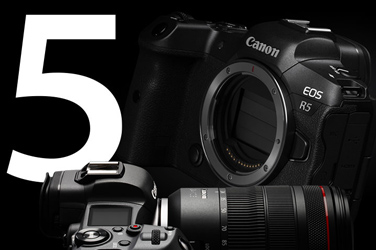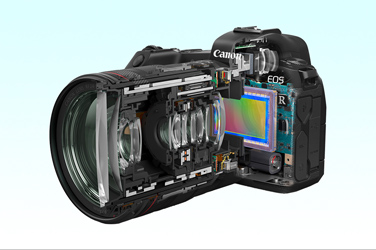Technology in ProductsDigital SLR Cameras
Lenses, sensors, and image processors.
Technologies that grant Canon an overwhelming market share.
Single-lens reflex (SLR) cameras allow photographers to view their subjects in real time through an optical viewfinder. These cameras contain a host of technological innovations in the form of such components as the lens, CMOS sensor, and image processor, and they have earned the trust of everyday, professional photographers.
September 12, 2022

How a digital SLR camera works
A digital SLR (DSLR) camera consists of four major components.
(1) Lens
Light reflected by the subject passes through the lens and enters the camera body.
(2) Optical viewfinder
The photographer can see the light once it enters the camera body and is reflected by a mirror.
(3) Image sensor
Light reaches the image sensor, where it is converted into digital information.
(4) Image processor
The digital information is converted into image data by the image processor.
↓
While checking the image, the photographer adjusts the amount of light, brightness, angle, and other settings. The photographer presses the shutter button to record the image data.
Read More
Canon’s DSLR camera technology
Image sensor technology
The performance of the image sensor is essential to the performance of any camera, mirrorless or DSLR. The key aspects required of the image sensor are high resolution and a high level of sensitivity. A high resolution allows a photographer to capture the finer details of a subject while a high level of sensitivity allows the photographer to take pictures in the dark with low signal noise.
Canon develops and produces its own sensors using its own proprietary technologies. The sensor features a high resolution and high level of sensitivity, resulting in a high resolution of approximately 45 megapixels in full size and a high level of sensitivity with a maximum native ISO of 51,200 (expanded ISO: equivalent to 102,400).

Image engine technology

Light entering through the camera lens is converted into electrical signals by the image sensor. The “DIGIC” image processor*1 reproduces natural colors and it delivers image data with rich tones and low noise from these signals. Since its development began in 2002, Canon’s DIGIC image processor has undergone a series of breakthroughs and its performance has improved, culminating in the latest version, DIGIC X. DIGIC has been optimized for both still image and video processing using proprietary algorithms, and it is capable of reducing noise while maintaining resolution, even in low-light environments. In addition to generating and processing beautiful still images and video, DIGIC is a high-performance system LSI*2 chip that uses a proprietary architecture to allow high-speed processing, thus facilitating autofocus, calculations to assess image stabilization, continuous shooting, and Live View mode.
*1 : A microcomputer that integrates a CPU core, memory to store programs, a timer, and input & output to & from an external source into a single integrated circuit.
*2 : A large-scale integrated circuit that integrates functions previously performed by a CPU, memory, and dedicated LSI on a single chip. A system LSI chip eliminates the need for complex wiring when multiple chips are used, resulting in faster operation. In addition, a single chip occupies less space on the main circuit board, thereby enabling smaller circuit boards and smaller cameras.
Dual-pixel CMOS AF
Dual-pixel CMOS AF is a revolutionary image sensor technology that uses a new CMOS sensor configuration in which every pixel has both image capture and phase-detection AF capabilities. In the Dual-pixel CMOS AF sensor, each pixel consists of two independent photodiodes that can output a signal, which can be used for phase-detection AF at the same time as the image capture signal. The two photodiodes can capture light independently. During phase-detection AF, signals from each photodiode are detected. During image capture, image signals from the two photodiodes are combined and output as a single pixel.
Dual-pixel CMOS AF video (11 sec.)
*In order to view videos, it is necessary to consent to the use of cookies by our website. If the videos are not displayed, please click the "Cookie Settings" and accept cookies.
Area AF (autofocus) technology
Since its debut in 1987, Canon’s EOS series of SLR cameras has continued to make an impact with the speed and comfort of its autofocus technology. From central single-point AF in the early days, cameras have continued to improve, offering 3-point AF (1990), 5-point AF (1992), 45-point area AF (1998), and 61-point AF (2012). The EOS-1D X Mark III, released in 2020, features advanced AF with a maximum of 191 points*, and the accuracy with which it measures distances has also improved.
* The number of AF points, cross-focusing points, and dual-cross-focusing points may vary depending on the lens used.

An optical viewfinder that captures the subject's movement in real time
One of the major features of DSLR cameras is that they are equipped with an optical viewfinder, which allows the photographer to see the subject in real time. The optical viewfinder of the EOS-1D X Mark III uses a pentaprism with a high refractive index in its optics, and a condenser lens (eyepiece lens) that focuses light using glass with a high refractive index, to provide a field of view of approximately 100% and a magnification of approximately 0.76x. The wide field of view and low aberration result in a clear field of view in the viewfinder with little change in visibility, even when the photographer’s line of sight deviates from the optical axis, and a clear, crisp view even at the periphery of the viewing area. The pentaprism, one of the distinctive components of DSLR cameras, must reflect light accurately and without distortion, and it must also provide bright light. Canon has used its advanced optical and production technologies to create pentaprisms that satisfy professionals.

EOS-1D X Mark III Optical Unit
High-speed continuous shooting up to approx. 16 frames per second
The EOS-1D X Mark III’s continuous shooting speed is up to approximately 16 frames per second (fps). This speed surpasses its predecessor model, the EOS-1D X Mark II, which shoots at approximately 14 fps. Elements of internal processing, from the CMOS sensor to the image engine and card writing, have been accelerated, and the mirror unit and the entire system’s drive arrangement have been redesigned. The image loss time refers to the time required to raise the mirror before releasing the shutter. The EOS-1D X Mark III ensures excellent viewfinder visibility while increasing frame speed, and the reduced image loss time enables the photographer to capture the moment they’re aiming for.

Comparison of viewfinder image loss time
New mirror actuating system
The mirror actuator in a DSLR camera is an important mechanism that determines the performance of the camera itself. Canon’s EOS-1D X Mark III uses a direct motor system to actuate the main mirror. The mirror is decelerated just before impact to suppress bouncing that would be caused by impact, and the mirror is instantly stabilized. In addition, a linkage has been developed to precisely coordinate the movements of the main mirror and sub-mirror. The sub-mirror can now also decelerate in conjunction with the braking of the main mirror, enabling instantaneous convergence of bouncing by both the main mirror and sub-mirror. This enables high-speed operation at a maximum of approximately 16 frames per second as well as high-precision AF.

Sub-mirror linkage (sub-mirror linking lever)

Diagram of the configuration of the mirror actuating system








